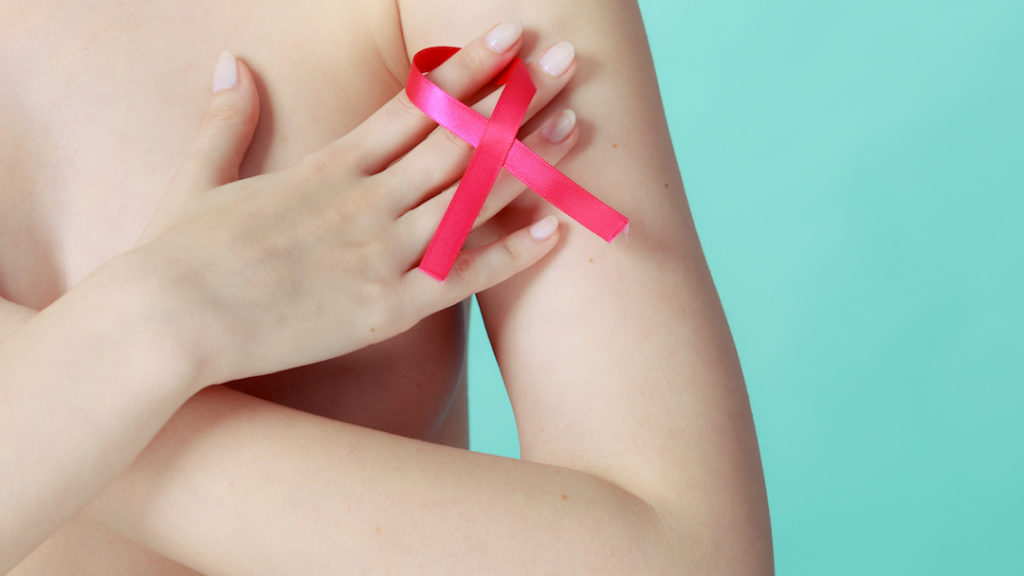Breast Cancer; What Is It?
October 2 2018What is Breast Cancer?

Breast Cancer; you may be familiar with the words, but do you actually know what it is? Well, all tissues in our body are made from cells, including the breasts. Cancer starts in the cells which make up the tissues.
In normal circumstances cells grow and divide as our body requires new cells. When cells get damaged or grow old they are replaced by new cells. Sometimes this natural process goes wrong and new cells appear without our body needing them, while old or damaged cells may build up rather than die. A gradual build up of these cells can form a lump, tumour or mass. Lumps in the breast can be benign (non-cancerous) or malignant (cancerous).
In most cases, breast lumps turn out to be non-cancerous and these benign lumps won’t spread to other parts of our body.However, malignant breast cancer cells can spread. They can move beyond the primary tumour and be transported via the lymph or blood vessels to other parts of the body. Sometimes these cells may attach to other tissues in the body and cause further tumours or growths. The spread of cancer in the body away from the primary tumour is called metastasis.
How Breast Cancer Develops
Have you ever given much thought to how our breasts actually work?
The female breast is made up of many lobes. Inside these lobes are smaller sections called lobules. Milk is produced in small glands inside the lobules. When a woman breast feeds her baby milk flows from the lobules through small ducts to the nipple.
Breast cancer develops in the ducts or the lobules of the breast.
Breast cancer develops when there are mutations in genes due to carcinogen (a substance that causes cancer in the body) exposure leading to DNA damage. It can also develop when there are errors in DNA replication, but these mutations can occur quite randomly.
In many genes, mutations can occur which have no impact, but mutation in some genes can lead to cancer.
Risk Factors for Breast Cancer
Each form of cancer has different risk factors that increase a person’s chance of getting a particular disease.
There are some strong risk factors for breast cancer, like first degree relatives diagnosed with breast cancer, that can’t be changed. In those cases, women should be talking to their doctor about their risk for breast cancer and screening regularly.
A person with one or more risk factors for breast cancer may not ever develop the disease but having them does increase the risk.
With breast cancer the risk factors may change with the passing of time.
An online questionnaire can help women figure out their likelihood of contracting the disease in the future. This questionnaire takes into account risk factorsm such as family history and lifestyle choices. To calculate your breast cancer risk visit https://breastcancerrisk.canceraustralia.gov.au.
Metastatic Breast Cancer
Sadly there is little treatment that can combat breast cancer when it metastases or spreads into other organs. This is because many patients become resistant to current treatments over time.. Over 75 per cent of patients with advanced stage breast cancer will have developed metastases into their bones, causing significant pain and side effects such as hypercalcaemia and fractures. Once the cancer reaches this stage chances of successful treatment are much slimmer.
Breast Cancer Statistics in Australia
- With 48 women diagnosed each day, breast cancer is one of the most commonly diagnosed cancers in Australia. (AIHW, 2017)
- One in eight women will be diagnosed with breast cancer by the age of 85. (AIHW, 2017)
- In 2017 it is estimated 17,586 new cases of breast cancer will be diagnosed in Australia. (AIHW, 2017)
- In 2017 it is estimated that 3,087 women will lose their battle to this heartbreaking disease, this makes breast cancer the second most commonly diagnosed cancer in Australian women. (AIHW, 2017)
- Early detection remains the best method for reducing breast cancer related deaths. Breast cancer mortality has continued to drop from around 30 deaths to 20 per 100,000 women between 1982 and 2014.
- Survival rates have improved significantly since the 1980’s with Australian based medical research playing a vital role in improving detection methods, diagnoses, treatment options and patient care.
- Breast cancer also affects Australian men. In 2017 it is estimated 144 cases of breast cancer in men will be diagnosed. (AIHW, 2017)
- The incidence of breast cancer increases with age. In 2017 it’s estimated around 21% of new cases will be diagnosed in women younger than 50 years; and 42% in those aged 65+.
- In 2014, the average age of diagnosis in Australian women was 61 years old.
- Given the ageing population, the number of women diagnosed with invasive breast cancer is expected to increase. Projections suggest that in 2018, the number of new breast cancer cases will be about 18,235. This would equate to 49 females being diagnosed with breast cancer every day.
Breast Awareness
Raising breast awareness is vital in detecting early changes in your breasts.
Early detection has been clearly demonstrated to increase the chances of better and more positive outcomes from breast cancer.
Performing regular self examinations and being aware of what to look for and what is normal for you and your breasts at different times of the month, is vitally important.
You should notify your GP or medical specialist if you notice any of the following changes:
- On-going pain in the breast
- Puckering, dimpling or redness of the skin on the breast
- Nipple discharge or changes in the look or position of the nipple
- Any lump or skin thickening in the breast tissue
- The breast feels unusual
Article originally appeared and sourced from the Australian Breast Cancer Research.
